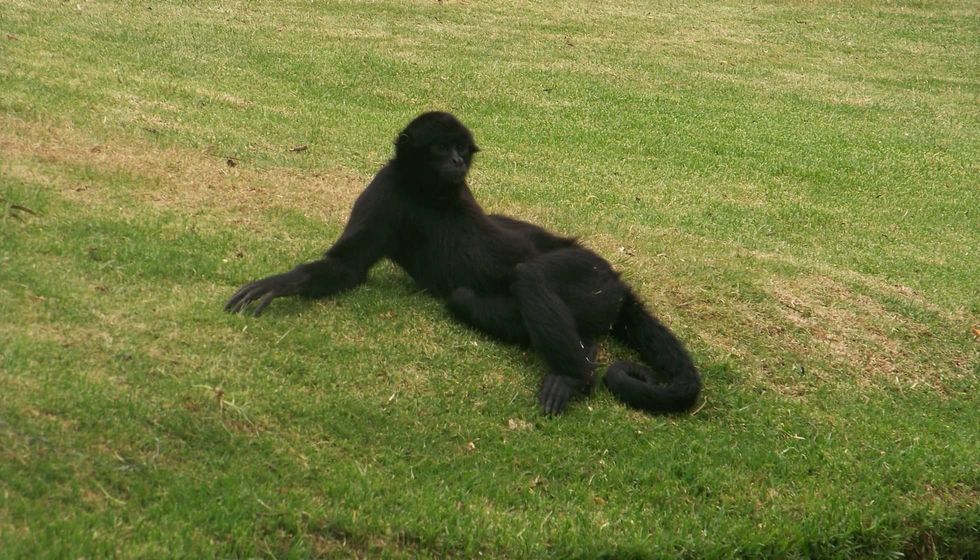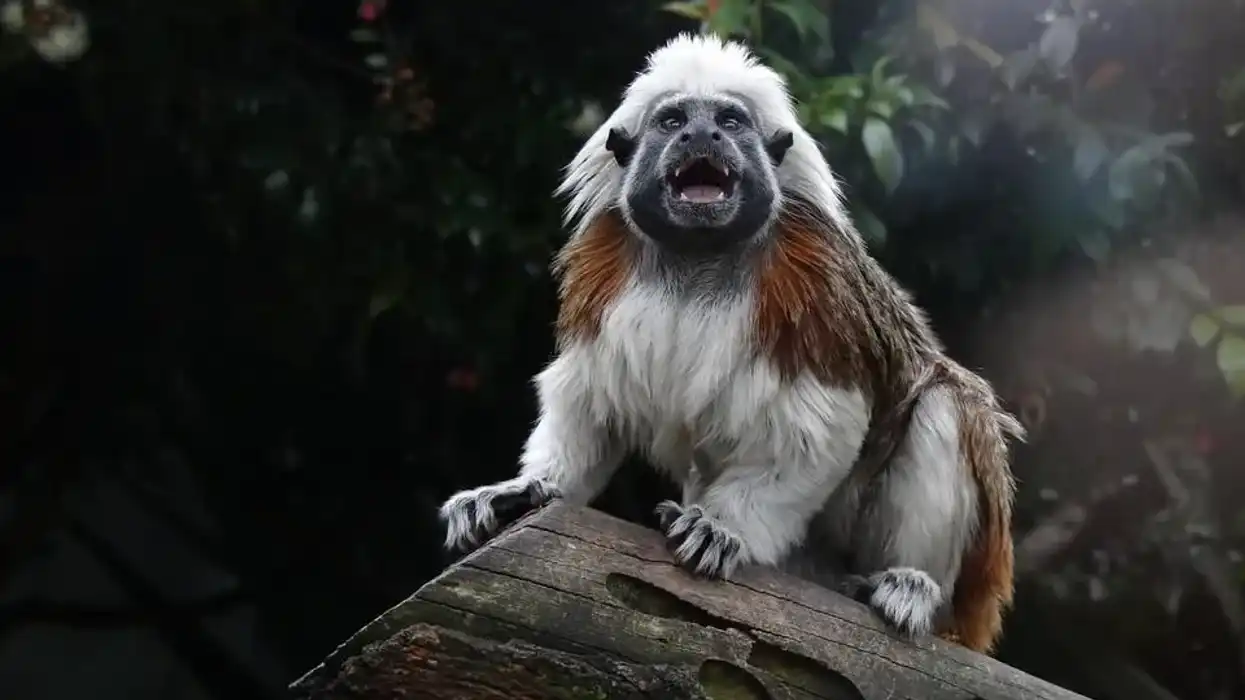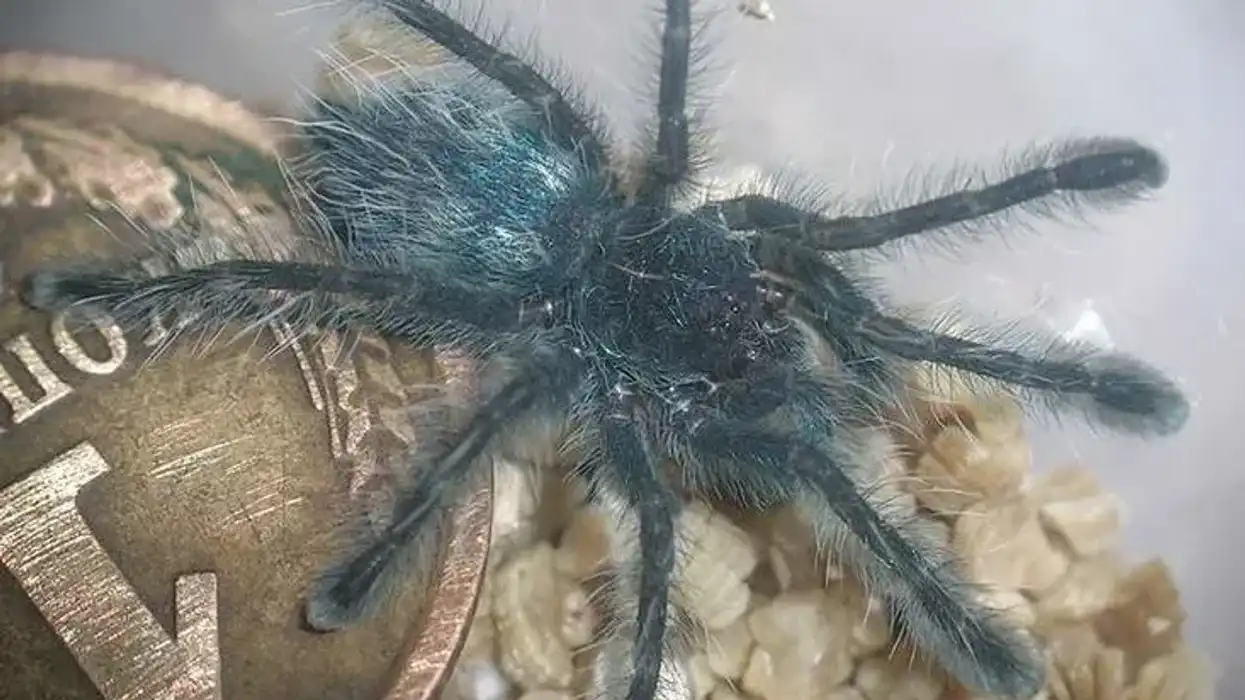Native members of the forest of northern South America, Black Spider Monkeys (Ateles paniscus), are a group of primate mammals. They are biologically categorized under the genus of Spider monkeys, that is, Atelidae.
The Black Spider Monkey (Ateles paniscus) along with its seven relatives under Atelidae are recognized members of the New World monkeys. The Black Spider Monkey's endangered status is due to its reduced population across its natural habitat because of habitat loss and poaching.
These are one of the largest primates in South America and have a powerful grasp on tree branches even though they have no thumbs. The jet-black body pattern with red faces makes these primates an endearing sight to behold.
Carry on with us to discover some amazing facts about these primates. Afterward, do check our other facts on the woolly monkey and patas monkey as well.
Black Spider Monkey Interesting Facts
What type of animal is a Black Spider Monkey?
The Black Spider Monkey (scientific name Ateles paniscus) is one of the largest species of Spider Monkeys in South America. Spider Monkeys are a family of primates under the genus Ateles, that are recognized as New World Monkeys. Out of proportion and long limbs along with long prehensile tails contribute to their large sizes.
What class of animal does a Black Spider Monkey belong to?
The Black Spider Monkey (scientific name Ateles fusciceps) belongs to the class Mammalia; that is, vertebrate organisms that are characterized by the presence of milk-producing mammary glands by which the females feed their young. The body is covered with fur or hair, the presence of a neocortex (a region of the brain), and three middle ear bones.
How many Black Spider Monkeys are there in the world?
Due to the declining population, the Ateles paniscus stand as Vulnerable species on the conservation scale. This decline in the population can be attributed to the shrinking Black Spider Monkey habitat and increasing predators of the Black Spider Monkey. Its distant cousin, the Brown Spider Monkey is listed as Critically Endangered.
Where does a Black Spider Monkey live?
Black Spider Monkeys are native residents of the rainforest of South America, north of the Amazon River. In specific terms, they can be located along the tropical forest range of Guyana, Suriname, French Guiana, and Brazil.
What is a Black Spider Monkey's habitat?
Dense forest settings with a canopy height over 83 ft (25.3 m) and isolated from the human population are their preferred habitat choices. They like to spend their time in trees with their group.
Who does Black Spider Monkey live with?
Black Spider Monkeys live, travel, and spend their time in trees in groups of about 20-30 members. The daytime activities such as traveling, resting, or feeding lead to a subdivision into groups, and sub packs are formed. Ateles paniscus is known to rarely associate with other primates.
How long does a Black Spider Monkey live?
The average lifespan of Black Spider Monkeys ranges between 20-27 years. However, the maximum reported age in the wilderness was about 37.8 years.
How do they reproduce?
During the courtship rituals, the male and female playfully wrestle, vocalize growling and panting as well as bob their head. These monkeys mate with multiple partners.
The female selects and favors their choices by sitting on the lap of the potential male; wherein, in the case of response mating proceeds, and when otherwise the female moves on to her next choice. Black Spider Monkeys are primate mammals and therefore undergo the estrus cycle.
The females give birth to a single baby every two to five years.
What is their conservation status?
According to the IUCN’s Red List, Black Spider Monkeys have been categorized under the conservation status of Vulnerable species, owing to their declining populations. Habitat loss and hunting are the major cause of this. Another member of the same species, Brown Spider Monkey is listed as Critically Endangered.
Black Spider Monkey Fun Facts
What do Black Spider Monkeys look like?
Belonging to the class Mammalia the body of these monkeys (except for the facial region) is covered with long, jet-black hair. Black Spider Monkeys like the other members of the Spider Monkey family possess long, disproportionate limbs.
The prehensile tail of Ateles paniscus is long and facilitates these organisms in grasping and holding the branches when journeying across the forest canopy. The head of this primate mammal is anatomically small in proportion to its body.
The male members of the species are slightly larger than their female counterparts. The facial region of Ateles paniscus is bare (except for a few white hairs) and is red or pink-toned.
How cute are they?
On a scale of five, Black Spider Monkeys can easily attain a four for their dark endearing, and beautiful looks. Black Spider Monkey behavior is extremely sweet and along with the friendly Black Spider Monkey characteristics, this species is regarded as extremely cute.
How do they communicate?
The communication channel in Black Spider Monkeys is based on visual, vocal, acoustic, and olfactory senses. The members of the species recognize each other by sniffing and licking the genital as well as chest regions.
When it comes to vocalizing, they grunt, whistle, scream, and bark to warn other members of predators and also to recognize the area where food can be found.
How big is a Black Spider Monkey?
The average length of these monkeys ranges between 16-24 in (40.6-61 cm) while the height is pegged at around 24-32 in (61-81.3 cm).
How fast can a Black Spider Monkey move?
There are no specific details about the speed of these monkeys. However, these are quite agile and graceful primates, skimming from canopy to canopy in their forest habitats.
How much does a Black Spider Monkey weigh?
The average weight of male Black Spider Monkeys is about 20 lb (9.1 kg), while the average weight of females is about 19 lb (8.6 kg). The weight of these animals is also dependent on their diet.
What are the male and female names of the species?
These monkeys have no distinct names for the genders. They attain sexual maturity at the age of four or five years.
What would you call a baby Black Spider Monkey?
The babies are referred to as infants, offsprings, or juveniles.
What do they eat?
The Black Spider Monkey's food habits make them omnivores. The Black Spider Monkey diet includes fruits (such as drupes, compound fruits, pods, and fleshy berries), flowers, mature seeds, leaves, and insects such as termites, grubs, and caterpillars.
Are they aggressive?
Like any other animal, Black Spider Monkeys are usually only dangerous when provoked or threatened. Otherwise, these primates prefer to abstain from human company. However, they live in packs and are quite territorial, it is extremely unwise to provoke them.
Would they make a good pet?
No, Black Spider Monkeys do not make a good pet option as this species is vulnerable to extinction. These monkeys are the free wanderers of the wilderness and might not prefer captivity.
They have been known to either show destructive and aggressive behavior when placed out of their natural habitation or they may become extremely scared and wary of other animals and humans impacting their health conditions.
Did you know...
Besides their scientific nomenclature Ateles paniscus, this monkey is also allocated some common designations such as the red-faced spider monkey, red-faced black spider monkey, or Guiana spider monkey
Why are Black Spider Monkeys endangered?
Dire circumstances such as loss of habitat and hunting of their numbers have led to a major decline in the population of Black Spider Monkeys. Owing to these threatening conditions the species is moving to the endangering situation of major population decline.
Another member of the same family, Brown Spider Monkey is listed as Critically Endangered. Predators of these species are mainly humans, as well as jaguars and pumas.
Where are the Black Spider Monkeys native to?
Black Spider Monkeys are native inhabitants of the rainforest of South America, north of the Amazon River.
Here at Kidadl, we have carefully created lots of interesting family-friendly animal facts for everyone to discover! Learn more about some other mammals from our Proboscis Monkey Fun Facts and Capuchin Monkey Facts pages.
You can even occupy yourself at home by coloring in one of our Black Spider Monkey coloring pages.










